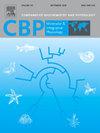Optimising hatchery release strategies: Size-dependent training effects on the swimming performance of juvenile Schizothorax wangchiachii
IF 2.2
3区 生物学
Q4 BIOCHEMISTRY & MOLECULAR BIOLOGY
Comparative Biochemistry and Physiology A-Molecular & Integrative Physiology
Pub Date : 2025-08-29
DOI:10.1016/j.cbpa.2025.111926
引用次数: 0
Abstract
The success of fish stock enhancement programmes is often limited by the high mortality of hatchery-reared individuals after their release. Poor swimming performance, a critical factor for survival, is a key reason for this low success rate. While exercise training can improve the physical fitness of fish, it is unclear whether these benefits are consistent across different sizes and developmental stages. Here, we aimed to determine how exercise training affects the aerobic and anaerobic swimming performance of the important economic fish, Schizothorax wangchiachii, across two different body size (age) classes. We subjected two sizes of hatchery-reared juvenile S. wangchiachii (4-month-old and 16-month-old) to 30 days of training. The fish underwent either high-speed aerobic training, low-speed aerobic training, anaerobic training, or were left untrained (control group). Following the training period, we measured their aerobic performance (critical swimming speed) and anaerobic performance (endurance time). We then compared these results with the performance of wild-caught juveniles of a similar age to the smaller cohort to gauge the effectiveness of the training. The training effects were strongly dependent on fish size. Aerobic exercise significantly improved the aerobic and anaerobic swimming performance of the smaller, 4-month-old juveniles. However, the training regimes had a much less pronounced effect on the larger, 16-month-old fish, with only their anaerobic performance showing some improvement. The low-speed aerobic training successfully raised the swimming capacity of the small hatchery-reared fish to a level that was not significantly different from their wild counterparts. Smaller juvenile S. wangchiachii benefit substantially more from aerobic exercise training than larger individuals. Therefore, considering both the training costs and the significant performance gains, implementing a low-speed aerobic exercise programme for smaller juveniles is the most effective and preferable strategy to prepare them for release, enhancing their potential for survival in the natural environment.

优化孵化放生策略:大小依赖性训练对汪家鲤幼鱼游泳性能的影响
鱼类资源增加计划的成功往往受到孵化场饲养的个体在放生后的高死亡率的限制。糟糕的游泳表现是生存的关键因素,也是这种低成功率的关键原因。虽然运动训练可以改善鱼类的身体健康,但目前尚不清楚这些益处是否在不同大小和发育阶段一致。在这里,我们的目的是确定运动训练如何影响重要的经济鱼类——王家鲤(Schizothorax wangchiachii)在两个不同体型(年龄)类别中的有氧和无氧游泳表现。我们对两种大小的孵化场饲养的王家鸡幼鱼(4月龄和16月龄)进行了30天的训练。这些鱼分别接受高速有氧训练、低速有氧训练、无氧训练或不接受训练(对照组)。训练结束后,我们测量了他们的有氧表现(临界游泳速度)和无氧表现(耐力时间)。然后,我们将这些结果与年龄相近的野生捕获的幼鱼的表现进行比较,以衡量训练的有效性。训练效果强烈依赖于鱼的大小。有氧运动显著提高了体型较小的4月龄幼鱼的有氧和无氧游泳成绩。然而,这种训练方式对较大的16个月大的鱼的影响要小得多,只有它们的无氧表现有所改善。低速有氧训练成功地将孵化场饲养的小型鱼类的游泳能力提高到与野生鱼类没有显著差异的水平。体型较小的王家鲤幼鱼从有氧运动训练中获得的益处明显大于体型较大的幼鱼。因此,考虑到训练成本和显著的性能收益,对较小的幼鱼实施低速有氧运动计划是最有效和最好的策略,可以为它们的释放做好准备,提高它们在自然环境中的生存潜力。
本文章由计算机程序翻译,如有差异,请以英文原文为准。
求助全文
约1分钟内获得全文
求助全文
来源期刊
CiteScore
5.00
自引率
4.30%
发文量
155
审稿时长
3 months
期刊介绍:
Part A: Molecular & Integrative Physiology of Comparative Biochemistry and Physiology. This journal covers molecular, cellular, integrative, and ecological physiology. Topics include bioenergetics, circulation, development, excretion, ion regulation, endocrinology, neurobiology, nutrition, respiration, and thermal biology. Study on regulatory mechanisms at any level of organization such as signal transduction and cellular interaction and control of behavior are also published.

 求助内容:
求助内容: 应助结果提醒方式:
应助结果提醒方式:


